Shaping Green Choices: How Sensory Cues Drive Behavior of Wood-Plastic Composites
Abstract
1. Introduction
2. Research Model and Hypotheses Development
2.1. The S-O-R Model
2.2. Stimuli and Organism
2.2.1. Material Stimuli
2.2.2. Surface Treatment Stimuli
2.2.3. Product Stimuli
2.2.4. Environmental Stimuli
2.3. Organism and Response
2.3.1. Perceived Uniqueness and Purchase Intention
2.3.2. Emotional Responses and Purchase Intention
2.3.3. Purchase Intention and Loyalty
2.4. Moderating Variable
3. Materials and Method
3.1. Stimuli
3.1.1. Preparation of WPCs
3.1.2. Surface Treatment Stimuli
3.1.3. Selection of Products
3.1.4. Environmental Stimulus Settings
3.2. Data Collection
3.3. Subjects
3.4. Data Analysis
4. Results
4.1. Measurement Model Assessment
4.2. Structural Model Evaluation
4.3. Analyzing the Moderating Role of Familiarity with Materials (Model 2)
4.4. Analysing the Direct and Indirect Effect
5. Discussion
6. Conclusions
Author Contributions
Funding
Institutional Review Board Statement
Informed Consent Statement
Data Availability Statement
Conflicts of Interest
Abbreviations
| WPCs | Wood-Plastic Composites |
| PCL | poly-ε-caprolactone |
| MS | Material Stimuli |
| ST | Surface Treatment Stimuli |
| PS | Product Stimuli |
| ES | Environmental Stimuli |
| PU | Perceived Uniqueness |
| ER | Emotional Response |
| PI | Purchase Intention |
| LY | Loyalty |
| SOR | Stimulus-Organism-Response |
Appendix A
| Construct | Items | Sources |
|---|---|---|
| Familiarity | I am very familiar with wood-plastic composites. | |
| Material Stimuli | Wood-plastic composites stimulate multiple sensory experiences for me. | (Gao & Lan, 2020) |
| The sensory characteristics of wood-plastic composites are diverse and rich. | ||
| The sensory performance of wood-plastic composites is appealing to me. | ||
| Surface Treatment Stimuli | Surface treatment enhances the sensory experience of the material. | (Desmet & Hekkert, 2007; Peck & Childers, 2003) |
| Surface treatment enhances the tactile appeal of wood-plastic composites. | ||
| Surface treatment enhances the visual appeal of wood-plastic composites. | ||
| Product Stimuli | Wood-plastic composites perform well in various products. | (Sweeney & Soutar, 2001) |
| I find wood-plastic composites acceptable in different types of products. | ||
| Products made of wood-plastic composites meet my quality standards. | ||
| Environmental Stimuli | Environmental factors enhance my overall sensory experience of wood-plastic composites. | (Naderi et al., 2020; Spence et al., 2014) |
| Environmental layout influences how I feel about the product/material. | ||
| The environment makes wood-plastic composites appear more attractive. | ||
| Perceived Uniqueness | Wood-plastic composites are significantly different from other materials in terms of sensory perception. | (Gao & Lan, 2020) |
| Wood-plastic composites stand out in their sensory characteristics. | ||
| Wood-plastic composites can distinguish themselves from other materials in sensory perception. | ||
| Emotional Response | Wood-plastic composites make me feel a connection to nature. | (Park et al., 2010; Spinelli et al., 2014) |
| Wood-plastic composites evoke positive emotions in me. | ||
| I have an emotional connection to wood-plastic composites. | ||
| Purchase Intention | I am likely to purchase products made from wood-plastic composites. | (Waheed et al., 2018) |
| Compared to other materials, I am more willing to buy products made from wood-plastic composites. | ||
| I am open to purchasing products made from wood-plastic composites. | ||
| Loyalty | I tend to use wood-plastic composites. | (Martínez & Del Bosque, 2013) |
| I would repurchase wood-plastic composites if needed. | ||
| I would recommend wood-plastic composites to others. |
Appendix B

References
- Agost, M.-J., & Vergara, M. (2020). Principles of affective design in consumers’ response to sustainability design strategies. Sustainability, 12(24), 10573. [Google Scholar] [CrossRef]
- Alba, J. W., & Hutchinson, J. W. (1987). Dimensions of consumer expertise. Journal of Consumer Research, 13(4), 411–454. [Google Scholar] [CrossRef]
- Anderson, J. C., & Gerbing, D. W. (1988). Structural equation modeling in practice: A review and recommended two-step approach. Psychological Bulletin, 103(3), 411. [Google Scholar] [CrossRef]
- Anderson, K. C., Knight, D. K., Pookulangara, S., & Josiam, B. (2014). Influence of hedonic and utilitarian motivations on retailer loyalty and purchase intention: A facebook perspective. Journal of Retailing and Consumer Services, 21(5), 773–779. [Google Scholar] [CrossRef]
- Argyris, Y. A., Muqaddam, A., & Miller, S. (2021). The effects of the visual presentation of an Influencer’s Extroversion on perceived credibility and purchase intentions—Moderated by personality matching with the audience. Journal of Retailing and Consumer Services, 59, 102347. [Google Scholar] [CrossRef]
- Arora, S., Parida, R. R., & Sahney, S. (2020). Understanding consumers’ showrooming behaviour: A stimulus–organism–response (S-O-R) perspective. International Journal of Retail & Distribution Management, 48(11), 1157–1176. [Google Scholar] [CrossRef]
- Asante-Kyei, K. (2018). Design and production of decorative flower pot from plastic wastes. American Journal of Art and Design, 3(4), 33–41. [Google Scholar]
- Ashby, M., & Johnson, K. (2003). The art of materials selection. Materials Today, 6(12), 24–35. [Google Scholar] [CrossRef]
- Bitner, M. J. (1992). Servicescapes: The impact of physical surroundings on customers and employees. Journal of Marketing, 56(2), 57–71. [Google Scholar] [CrossRef]
- Broman, N. O. (2001). Aesthetic properties in knotty wood surfaces and their connection with people’s preferences. Journal of Wood Science, 47(3), 192–198. [Google Scholar] [CrossRef]
- Calvo Porral, C., & Levy-Mangin, J.-P. (2016). Food private label brands: The role of consumer trust on loyalty and purchase intention. British Food Journal, 118(3), 679–696. [Google Scholar] [CrossRef]
- Carpenter, C. W., Dhong, C., Root, N. B., Rodriquez, D., Abdo, E. E., Skelil, K., Alkhadra, M. A., Ramírez, J., Ramachandran, V. S., & Lipomi, D. J. (2018). Human ability to discriminate surface chemistry by touch. Materials Horizons, 5(1), 70–77. [Google Scholar] [CrossRef]
- Chan, W. Y., To, C. K. M., & Chu, W. C. (2015). Materialistic consumers who seek unique products: How does their need for status and their affective response facilitate the repurchase intention of luxury goods? Journal of Retailing and Consumer Services, 27, 1–10. [Google Scholar] [CrossRef]
- Chang, H. H., & Tuan Pham, M. (2013). Affect as a decision-making system of the present. Journal of Consumer Research, 40(1), 42–63. [Google Scholar] [CrossRef]
- Chaudhuri, A. (2006). Emotion and reason in consumer behavior. Routledge. [Google Scholar]
- Chen, X., Liu, Y., Li, S., & Sun, W. (2022). Sensory perception mechanism for preparing the combinations of stimuli operation in the architectural experience. Sustainability, 14(13), 7885. [Google Scholar] [CrossRef]
- Chen, Y.-T., & Chuang, M.-C. (2014). The study of tactile feeling and It’s expressing vocabulary. International Journal of Industrial Ergonomics, 44(5), 675–684. [Google Scholar] [CrossRef]
- Chopdar, P. K., & Balakrishnan, J. (2020). Consumers response towards mobile commerce applications: S-O-R approach. International Journal of Information Management, 53, 102106. [Google Scholar] [CrossRef]
- Chowdhury, A., Reddy, S. M., Chakrabarti, D., & Karmakar, S. (2015). Cognitive theories of product emotion and their applications in emotional product design. In ICoRD’15–Research into design across boundaries volume 1: Theory, research methodology, aesthetics, human factors and education. Springer. [Google Scholar]
- Cronbach, L. J. (1951). Coefficient alpha and the internal structure of tests. Psychometrika, 16(3), 297–334. [Google Scholar] [CrossRef]
- Das, G. (2015). Linkages between self-congruity, brand familiarity, perceived quality and purchase intention: A study of fashion retail brands. Journal of Global Fashion Marketing, 6(3), 180–193. [Google Scholar] [CrossRef]
- Das, G., & Varshneya, G. (2017). Consumer emotions: Determinants and outcomes in a shopping mall. Journal of Retailing and Consumer Services, 38, 177–185. [Google Scholar] [CrossRef]
- Das, M., Habib, M., Saha, V., & Jebarajakirthy, C. (2021). Bandwagon vs snob luxuries: Targeting consumers based on uniqueness dominance. Journal of Retailing and Consumer Services, 61, 102582. [Google Scholar] [CrossRef]
- Demirbilek, O., & Sener, B. (2003). Product design, semantics and emotional response. Ergonomics, 46(13–14), 1346–1360. [Google Scholar] [CrossRef] [PubMed]
- Desmet, P., & Hekkert, P. (2007). Framework of product experience. International Journal of Design, 1(1), 57–66. [Google Scholar]
- Ding, S., Pan, Y., Tong, M., & Zhao, X. (2017). Tactile perception of roughness and hardness to discriminate materials by friction-induced vibration. Sensors, 17(12), 2748. [Google Scholar] [CrossRef] [PubMed]
- D’Souza, M. E., Hancock, P. A., Hoonhout, H. C. M., Krout, K., Ohme, P. J., & Walline, E. K. (2010). Designing products to evoke an emotional connection in users. Proceedings of the Human Factors and Ergonomics Society Annual Meeting, 54(20), 1747–1751. [Google Scholar] [CrossRef]
- Duarte Poblete, S. S., Romani, A., & Rognoli, V. (2024). Emerging materials for transition: A taxonomy proposal from a design perspective. Sustainable Futures, 7, 100155. [Google Scholar] [CrossRef]
- Fang, X., Li, L., Gao, Y., Liu, N., & Cheng, L. (2024). Expressing the spatial concepts of interior spaces in residential buildings of Huizhou, China: Narrative methods of wood-carving imagery. Buildings, 14(5), 1414. [Google Scholar] [CrossRef]
- Faucheu, J., Weiland, B., Juganaru-Mathieu, M., Witt, A., & Cornuault, P.-H. (2019). Tactile aesthetics: Textures that we like or hate to touch. Acta Psychologica, 201, 102950. [Google Scholar] [CrossRef]
- Favier, M., Jaud, D. A., & Saintives, C. (2024). Make it unique! Why embossed product labels increase purchase intentions and willingness to pay. Journal of Product & Brand Management, 34(2), 173–185. [Google Scholar] [CrossRef]
- Fiore, A. M., Yah, X., & Yoh, E. (2000). Effects of a product display and environmental fragrancing on approach responses and pleasurable experiences. Psychology & Marketing, 17(1), 27–54. [Google Scholar] [CrossRef]
- Fleming, R. W. (2017). Material perception. Annual Review of Vision Science, 3, 365–388. [Google Scholar] [CrossRef] [PubMed]
- Fornell, C., & Larcker, D. F. (1981). Evaluating structural equation models with unobservable variables and measurement error. Journal of Marketing Research, 18(1), 39–50. [Google Scholar] [CrossRef]
- Franke, N., & Piller, F. (2004). Value creation by toolkits for user innovation and design: The case of the watch market. Journal of Product Innovation Management, 21(6), 401–415. [Google Scholar] [CrossRef]
- Franke, N., & Schreier, M. (2008). Product uniqueness as a driver of customer utility in mass customization. Marketing Letters, 19(2), 93–107. [Google Scholar] [CrossRef]
- Franz, G. (2006). Space, color, and perceived qualities of indoor environments. In Environment, health and sustainable development (IAPS 19). MPG.PuRe. [Google Scholar]
- Gao, F., & Lan, X. (2020). Sensory brand experience: Development and validation in the Chinese context. Frontiers in Psychology, 11, 1436. [Google Scholar] [CrossRef]
- Giaccardi, E., & Karana, E. (2015, April 18–23). Foundations of materials experience: An approach for HCI. Proceedings of the 33rd Annual ACM Conference on Human Factors in Computing Systems, Seoul, Republic of Korea. [Google Scholar] [CrossRef]
- Harris, K. L., Collier, E. S., Skedung, L., & Rutland, M. W. (2021). A sticky situation or rough going? Influencing haptic perception of wood coatings through frictional and topographical design. Tribology Letters, 69(3), 113. [Google Scholar] [CrossRef]
- Hayes, A. F., & Scharkow, M. (2013). The relative trustworthiness of inferential tests of the indirect effect in statistical mediation analysis: Does method really matter? Psychological Science, 24(10), 1918–1927. [Google Scholar] [CrossRef] [PubMed]
- He, Z., Zhou, Y., Wang, J., Shen, W., Li, W., & Lu, W. (2023). Influence of emotion on purchase intention of electric vehicles: A comparative study of consumers with different income levels. Current Psychology, 42(25), 21704–21719. [Google Scholar] [CrossRef]
- Heitmann, M., Landwehr, J. R., Schreiner, T. F., & Van Heerde, H. J. (2020). Leveraging brand equity for effective visual product design. Journal of Marketing Research, 57(2), 257–277. [Google Scholar] [CrossRef]
- Henseler, J., Ringle, C. M., & Sarstedt, M. (2016). Testing measurement invariance of composites using partial least squares. International Marketing Review, 33(3), 405–431. [Google Scholar] [CrossRef]
- Hewei, T., & Youngsook, L. (2022). Factors affecting continuous purchase intention of fashion products on social E-commerce: SOR model and the mediating effect. Entertainment Computing, 41, 100474. [Google Scholar] [CrossRef]
- Higuera-Trujillo, J. L., Llinares, C., & Macagno, E. (2021). The cognitive-emotional design and study of architectural space: A scoping review of neuroarchitecture and its precursor approaches. Sensors, 21(6), 2193. [Google Scholar] [CrossRef]
- Hong, I. B., & Cho, H. (2011). The impact of consumer trust on attitudinal loyalty and purchase intentions in B2C e-marketplaces: Intermediary trust vs. seller trust. International Journal of Information Management, 31(5), 469–479. [Google Scholar] [CrossRef]
- Jani, D., & Han, H. (2015). Influence of environmental stimuli on hotel customer emotional loyalty response: Testing the moderating effect of the big five personality factors. International Journal of Hospitality Management, 44, 48–57. [Google Scholar] [CrossRef]
- Kabadayi, E. T., Aksoy, N. C., & Turkay, P. B. (2023). How does customer engagement value occur in restaurants? A stimulus-organism-response (SOR) perspective. The Service Industries Journal, 43(7–8), 497–524. [Google Scholar] [CrossRef]
- Karana, E. (2012). Characterization of ‘natural’ and ‘high-quality’ materials to improve perception of bio-plastics. Journal of Cleaner Production, 37, 316–325. [Google Scholar] [CrossRef]
- Karana, E., Pedgley, O., & Rognoli, V. (2015). On materials experience. Design Issues, 31(3), 16–27. [Google Scholar] [CrossRef]
- Kawulur, A., Sumakul, G., & Pandowo, A. (2022). Purchase intention of second-hand: A case study of generation Z. SHS Web Conference, 149, 02026. [Google Scholar] [CrossRef]
- Khamtree, S., Srivabut, C., Khamtree, S., & Kaewmai, R. (2024). Effects of natural fiber waste, content, and coupling agent on the physical and mechanical properties of wood species–plastic composites as green materials. Fibers and Polymers, 25(4), 1391–1402. [Google Scholar] [CrossRef]
- Kim, J., & Lennon, S. J. (2013). Effects of reputation and website quality on online consumers’ emotion, perceived risk and purchase intention. Journal of Research in Interactive Marketing, 7(1), 33–56. [Google Scholar] [CrossRef]
- Köster, E. P., & Mojet, J. (2015). From mood to food and from food to mood: A psychological perspective on the measurement of food-related emotions in consumer research. Food Research International, 76, 180–191. [Google Scholar] [CrossRef]
- Krause, F., Görgen, J., de Bellis, E., Franke, N., Burghartz, P., Klanner, I.-M., & Häubl, G. (2023). One-of-a-kind products: Leveraging strict uniqueness in mass customization. International Journal of Research in Marketing, 40(4), 823–840. [Google Scholar] [CrossRef]
- Ladhari, R., Brun, I., & Morales, M. (2008). Determinants of dining satisfaction and post-dining behavioral intentions. International Journal of Hospitality Management, 27(4), 563–573. [Google Scholar] [CrossRef]
- Lanzoni, S., Guardigli, L., & Pizzardi, P. (2025). Twenty years of applied experimental research on wood-plastic composites. An Italian case study. Discover Civil Engineering, 2(1), 44. [Google Scholar] [CrossRef]
- Laroche, M., Li, R., Richard, M.-O., & Zhou, M. (2022). An investigation into online atmospherics: The effect of animated images on emotions, cognition, and purchase intentions. Journal of Retailing and Consumer Services, 64, 102845. [Google Scholar] [CrossRef]
- Lee, K. (2022). The interior experience of architecture: An emotional connection between space and the body. Buildings, 12(3), 326. [Google Scholar] [CrossRef]
- Lee, Y., Ho, F. N., & Wu, M.-C. (2018). How do form and functional newness affect adoption preference? The moderating role of consumer need for uniqueness. Journal of Consumer Marketing, 35(1), 79–90. [Google Scholar] [CrossRef]
- Li, C., Wang, L., & Zhang, L. (2024). A case study in natural fibre material (luffa sponge) development using E2-material-driven design. Sustainability, 16(8), 3490. [Google Scholar] [CrossRef]
- Li, J., Wu, J., Lam, F., Zhang, C., Kang, J., & Xu, H. (2021). Effect of the degree of wood use on the visual psychological response of wooden indoor spaces. Wood Science and Technology, 55(5), 1485–1508. [Google Scholar] [CrossRef]
- Liaw, G.-F. (2007, October 13–14). The influence of multiple store environment cues on shopping mood and patronage satisfaction. 7th Global Conference on Business and Economics, Rome, Italy. [Google Scholar]
- Likert, R. (1932). A technique for the measurement of attitudes. Archives of Psychology, 22(140), 55. [Google Scholar]
- Lin, B., & Shen, B. (2023). Study of consumers’ purchase intentions on community E-commerce platform with the SOR model: A case study of China’s “Xiaohongshu” app. Behavioral Sciences, 13(2), 103. [Google Scholar] [CrossRef]
- Lin, I. Y. (2004). Evaluating a servicescape: The effect of cognition and emotion. International Journal of Hospitality Management, 23(2), 163–178. [Google Scholar] [CrossRef]
- Ling, H.-C., Chen, H.-R., Ho, K. K. W., & Hsiao, K.-L. (2021). Exploring the factors affecting customers’ intention to purchase a smart speaker. Journal of Retailing and Consumer Services, 59, 102331. [Google Scholar] [CrossRef]
- Ma, Z., Yang, Z., & Mourali, M. (2014). Consumer adoption of new products: Independent versus interdependent self-perspectives. Journal of Marketing, 78(2), 101–117. [Google Scholar] [CrossRef]
- Mainardes, E. W., & Cardoso, M. V. (2019). Effect of the use of social media in trust, loyalty and purchase intention in physical stores. The International Review of Retail, Distribution and Consumer Research, 29(4), 456–477. [Google Scholar] [CrossRef]
- Manu, T., Nazmi, A. R., Shahri, B., Emerson, N., & Huber, T. (2022). Biocomposites: A review of materials and perception. Materials Today Communications, 31, 103308. [Google Scholar] [CrossRef]
- Maraveas, C. (2020). Production of sustainable and biodegradable polymers from agricultural waste. Polymers, 12(5), 1127. [Google Scholar] [CrossRef] [PubMed]
- Marschallek, B. E., & Jacobsen, T. (2022). Smooth and hard or beautiful and elegant? Experts’ conceptual structure of the aesthetics of materials. SAGE Open, 12(2), 21582440221096130. [Google Scholar] [CrossRef]
- Martínez, P., & Del Bosque, I. R. (2013). CSR and customer loyalty: The roles of trust, customer identification with the company and satisfaction. International Journal of Hospitality Management, 35, 89–99. [Google Scholar] [CrossRef]
- Mayo, J. (2015). Solid wood: Case studies in mass timber architecture, technology and design. Routledge. [Google Scholar]
- Mehrabian, A. (1974). An approach to environmental psychology. In Massachusetts institute of technology. The MIT Press. [Google Scholar]
- Meiselman, H. L. (2015). A review of the current state of emotion research in product development. Food Research International, 76, 192–199. [Google Scholar] [CrossRef]
- Meng, L., Duan, S., Zhao, Y., Lü, K., & Chen, S. (2021). The impact of online celebrity in livestreaming E-commerce on purchase intention from the perspective of emotional contagion. Journal of Retailing and Consumer Services, 63, 102733. [Google Scholar] [CrossRef]
- Meyn, S. (2008). Control techniques for complex networks. Cambridge University Press. [Google Scholar]
- Mim, K. B., Jai, T., & Lee, S. H. (2022). The influence of sustainable positioning on eWOM and brand loyalty: Analysis of credible sources and transparency practices based on the S-O-R model. Sustainability, 14(19), 12461. [Google Scholar] [CrossRef]
- Mullet, G. M., & Karson, M. J. (1985). Analysis of purchase intent scales weighted by probability of actual purchase. Journal of Marketing Research, 22(1), 93–96. [Google Scholar] [CrossRef]
- Naderi, E., Naderi, I., & Balakrishnan, B. (2020). Product design matters, but is it enough? Consumers’ responses to product design and environment congruence. Journal of Product & Brand Management, 29(7), 939–954. [Google Scholar]
- Nakamura, M., Masuda, M., & Hiramatsu, Y. (1994). Visual factors influencing psychological images of woods and stones. Journal of the Japan Wood Research Society, 40(4), 364–371. [Google Scholar]
- Nazrin, A., Sapuan, S. M., Zuhri, M. Y. M., Ilyas, R. A., Syafiq, R., & Sherwani, S. F. K. (2020). Nanocellulose reinforced thermoplastic starch (TPS), polylactic acid (PLA), and polybutylene succinate (PBS) for food packaging applications [review]. Frontiers in Chemistry, 8, 213. [Google Scholar] [CrossRef]
- Nieves-Pavón, S., López-Mosquera, N., & Jiménez-Naranjo, H. (2023). The factors influencing STD through SOR theory. Journal of Retailing and Consumer Services, 75, 103533. [Google Scholar] [CrossRef]
- Nurazzi, N. M., Asyraf, M. R. M., Khalina, A., Abdullah, N., Aisyah, H. A., Rafiqah, S. A., Sabaruddin, F. A., Kamarudin, S. H., Norrrahim, M. N. F., Ilyas, R. A., & Sapuan, S. M. (2021). A review on natural fiber reinforced polymer composite for bullet proof and ballistic applications. Polymers, 13(4), 646. [Google Scholar] [CrossRef]
- Olsen, S. O., Skallerud, K., & Heide, M. (2021). Consumers’ evaluation and intention to buy traditional seafood: The role of vintage, uniqueness, nostalgia and involvement in luxury. Appetite, 157, 104994. [Google Scholar] [CrossRef]
- Oye, D. J. (2022). Assessment and impact of outdoor seating area in campus environment: A case study of faculty of environmental sciences. University of Benin. [Google Scholar]
- Özgen, C., Kim, E., Köse, H., Balcı, V., & Çevik, H. (2024). How expanded servicescape shapes fitness center members’ decision-making processes: A stimulus-organism-response (SOR) model perspective. International Journal of Sports Marketing and Sponsorship. [Google Scholar] [CrossRef]
- Pallasmaa, J. (2024). The eyes of the skin: Architecture and the senses. John Wiley & Sons. [Google Scholar]
- Park, C. W., MacInnis, D. J., Priester, J., Eisingerich, A. B., & Iacobucci, D. (2010). Brand attachment and brand attitude strength: Conceptual and empirical differentiation of two critical brand equity drivers. Journal of Marketing, 74(6), 1–17. [Google Scholar] [CrossRef]
- Peck, J., & Childers, T. L. (2003). To have and to hold: The influence of haptic information on product judgments. Journal of Marketing, 67(2), 35–48. [Google Scholar] [CrossRef]
- Raghunathan, R., & Pham, M. T. (1999). All negative moods are not equal: Motivational influences of anxiety and sadness on decision making. Organizational Behavior and Human Decision Processes, 79(1), 56–77. [Google Scholar] [CrossRef]
- Rindova, V. P., & Petkova, A. P. (2007). When is a new thing a good thing? Technological change, product form design, and perceptions of value for product innovations. Organization Science, 18(2), 217–232. [Google Scholar] [CrossRef]
- Rognoli, V., Karana, E., & Pedgley, O. (2011, June 22–25). Natural fibre composites in product design: An investigation into material perception and acceptance. 2011 Conference on Designing Pleasurable Products and Interfaces, Milano, Italy. [Google Scholar]
- Rognoli, V., Petreca, B., Pollini, B., & Saito, C. (2022). Materials biography as a tool for designers’ exploration of bio-based and bio-fabricated materials for the sustainable fashion industry. Sustainability: Science, Practice and Policy, 18(1), 749–772. [Google Scholar] [CrossRef]
- Roseman, I. J., & Smith, C. A. (2001). Appraisal theory: Overview, assumptions, varieties, controversies. In Appraisal processes in emotion: Theory, methods, research (pp. 3–19). Oxford University Press. [Google Scholar]
- Rotimi, J. O. B., Moshood, T. D., & Rotimi, F. E. (2024). The potential challenges and limitations of implementing modern office design features in residential spaces: A SPAR-4-SLR approach. Buildings, 14(10), 3037. [Google Scholar] [CrossRef]
- Sakuragawa, S. (2006). Change in the impression of rooms with interior wood finishes arranged differently: Questionnaire survey with the use of photographs for the analysis of impressions of rooms concerning living activities. Journal of Wood Science, 52, 290–294. [Google Scholar] [CrossRef]
- Sauerwein, M., Karana, E., & Rognoli, V. (2017). Revived beauty: Research into aesthetic appreciation of materials to valorise materials from waste. Sustainability, 9(4), 529. [Google Scholar] [CrossRef]
- Schifferstein, H. N., & Zwartkruis-Pelgrim, E. P. (2008). Consumer-product attachment: Measurement and design implications. International Journal of Design, 2(3), 1–13. [Google Scholar]
- Schmidt, F., Hebart, M. N., Schmid, A. C., & Fleming, R. W. (2025). Core dimensions of human material perception. Proceedings of the National Academy of Sciences, 122(10), e2417202122. [Google Scholar] [CrossRef]
- Schreuder, E., van Erp, J., Toet, A., & Kallen, V. L. (2016). Emotional responses to multisensory environmental stimuli: A conceptual framework and literature review. Sage Open, 6(1), 2158244016630591. [Google Scholar] [CrossRef]
- Schwarzkopf, M. J., & Burnard, M. D. (2016). Wood-plastic composites—Performance and environmental impacts. In Environmental impacts of traditional and innovative forest-based bioproducts (pp. 19–43). Springer. [Google Scholar]
- Schweiker, M., Ampatzi, E., Andargie, M. S., Andersen, R. K., Azar, E., Barthelmes, V. M., Berger, C., Bourikas, L., Carlucci, S., Chinazzo, G., Edappilly, L. P., Favero, M., Gauthier, S., Jamrozik, A., Kane, M., Mahdavi, A., Piselli, C., Pisello, A. L., Roetzel, A., … Zhang, S. (2020). Review of multi-domain approaches to indoor environmental perception and behaviour. Building and Environment, 176, 106804. [Google Scholar] [CrossRef]
- Shi, X., Li, F., & Chumnumpan, P. (2020). The use of product scarcity in marketing. European Journal of Marketing, 54(2), 380–418. [Google Scholar] [CrossRef]
- Sivaram, M., Hudaya, A., & Ali, H. (2019). Building a purchase and purchase decision: Analysis of brand awareness and brand Loyalty. Dinasti International Journal of Education Management And Social Science, 1(2), 235–248. [Google Scholar]
- Skedung, L., Arvidsson, M., Chung, J. Y., Stafford, C. M., Berglund, B., & Rutland, M. W. (2013). Feeling small: Exploring the tactile perception limits. Scientific Reports, 3(1), 2617. [Google Scholar] [CrossRef] [PubMed]
- Skedung, L., Harris, K., Collier, E. S., Arvidsson, M., Wäckerlin, A., Haag, W., Bieri, M., Romanyuk, A., & Rutland, M. W. (2018). Feeling smooth: Psychotribological probing of molecular composition. Tribology Letters, 66, 1–10. [Google Scholar] [CrossRef]
- Skedung, L., Harris, K. L., Collier, E. S., & Rutland, M. W. (2020). The finishing touches: The role of friction and roughness in haptic perception of surface coatings. Experimental Brain Research, 238(6), 1511–1524. [Google Scholar] [CrossRef]
- Smardzewski, J. (2015). Furniture design (Vol. 201510). Springer. [Google Scholar]
- Smith, S. G. (1994). The essential qualities of a home. Journal of Environmental Psychology, 14(1), 31–46. [Google Scholar] [CrossRef]
- So, K. K. F., Kim, H., & Oh, H. (2021). What makes airbnb experiences enjoyable? The effects of environmental stimuli on perceived enjoyment and repurchase intention. Journal of Travel Research, 60(5), 1018–1038. [Google Scholar] [CrossRef]
- Spence, C., & Gallace, A. (2011). Multisensory design: Reaching out to touch the consumer. Psychology & Marketing, 28(3), 267–308. [Google Scholar] [CrossRef]
- Spence, C., Puccinelli, N. M., Grewal, D., & Roggeveen, A. L. (2014). Store atmospherics: A multisensory perspective. Psychology & Marketing, 31(7), 472–488. [Google Scholar] [CrossRef]
- Spinelli, S., Masi, C., Dinnella, C., Zoboli, G. P., & Monteleone, E. (2014). How does it make you feel? A new approach to measuring emotions in food product experience. Food Quality and Preference, 37, 109–122. [Google Scholar] [CrossRef]
- Stamps, A. E., III. (1990). Use of photographs to simulate environments: A meta-analysis. Perceptual and Motor Skills, 71(3), 907–913. [Google Scholar] [CrossRef]
- Stamps, A. E., III. (2010). Use of static and dynamic media to simulate environments: A meta-analysis. Perceptual and Motor Skills, 111(2), 355–364. [Google Scholar] [CrossRef]
- Stark, N., & Cai, Z. (2021). Wood-based composite materials: Panel products, glued laminated timber, structural composite lumber, and wood–nonwood composites. In Wood handbook—wood as an engineering material (pp. 11–29). Department of Agriculture, Forest Service, Forest Products Laboratory. [Google Scholar]
- Sun, M., Nakashima, T., Yoshimura, Y., Honden, A., Nakagawa, T., Saijo, H., Watanabe, Y., Ajimi, T., Yasunari, S., Yamada, Y., Nagano, J., Okamoto, T., Ishikawa, H., Ohnuki, K., Fujimoto, N., & Shimizu, K. (2020). Effects and interaction of different interior material treatment and personal preference on psychological and physiological responses in living environment. Journal of Wood Science, 66(1), 63. [Google Scholar] [CrossRef]
- Sun, Q., Lai, Y., & Shi, H. (2020). Application analysis of WF/HDPE composite in landscape design. In IOP conference series: Earth and environmental science. IOP Publishing. [Google Scholar]
- Sunstrum, F. N., Demirbilek, O., Gardner, N., Viengkham, C., & Spehar, B. (2024). Revealing the synergy between formal aesthetics and product semantics: Exploring the impact of visual form on product perception. International Journal of Industrial Ergonomics, 101, 103593. [Google Scholar] [CrossRef]
- Sweeney, J. C., & Soutar, G. N. (2001). Consumer perceived value: The development of a multiple item scale. Journal of Retailing, 77(2), 203–220. [Google Scholar] [CrossRef]
- Thundathil, M., Emerson, N. J., Nazmi, A. R., Shahri, B., Müssig, J., & Huber, T. (2024). Tactility in perception of biobased composites. Proceedings of the Design Society, 4, 1467–1476. [Google Scholar] [CrossRef]
- Thundathil, M., Nazmi, A. R., Shahri, B., Emerson, N., Müssig, J., & Huber, T. (2023a). Designing with biobased composites: Understanding digital material perception through semiotic attributes. Design Science, 9, e6. [Google Scholar] [CrossRef]
- Thundathil, M., Nazmi, A. R., Shahri, B., Emerson, N., Müssig, J., & Huber, T. (2023b). Visual–tactile perception of biobased composites. Materials, 16(5), 1844. [Google Scholar] [CrossRef]
- Tian, K. T., Bearden, W. O., & Hunter, G. L. (2001). Consumers’ need for uniqueness: Scale development and validation. Journal of Consumer Research, 28(1), 50–66. [Google Scholar] [CrossRef]
- Ulrich, R. S. (1983). Aesthetic and affective response to natural environment. In Behavior and the natural environment (pp. 85–125). Springer. [Google Scholar]
- Veryzer, R. W., Jr., & Hutchinson, J. W. (1998). The influence of unity and prototypicality on aesthetic responses to new product designs. Journal of Consumer Research, 24(4), 374–394. [Google Scholar] [CrossRef]
- Waheed, S., Khan, M. M., & Ahmad, N. (2018). Product packaging and consumer purchase intentions. Market Forces, 13(2), 97–114. [Google Scholar]
- Wastiels, L., Schifferstein, H. N. J., Heylighen, A., & Wouters, I. (2012). Relating material experience to technical parameters: A case study on visual and tactile warmth perception of indoor wall materials. Building and Environment, 49, 359–367. [Google Scholar] [CrossRef]
- Wilkes, S., Wongsriruksa, S., Howes, P., Gamester, R., Witchel, H., Conreen, M., Laughlin, Z., & Miodownik, M. (2016). Design tools for interdisciplinary translation of material experiences. Materials & Design, 90, 1228–1237. [Google Scholar] [CrossRef]
- Workman, J. E., & Caldwell, L. F. (2007). Centrality of visual product aesthetics, tactile and uniqueness needs of fashion consumers. International Journal of Consumer Studies, 31(6), 589–596. [Google Scholar] [CrossRef]
- Zanger, V., Meißner, M., & Rauschnabel, P. A. (2022). Beyond the gimmick: How affective responses drive brand attitudes and intentions in augmented reality marketing. Psychology & Marketing, 39(7), 1285–1301. [Google Scholar] [CrossRef]
- Zhang, L., Rodríguez Urribarrí, A. C., Wang, H., Zhang, S., Zhang, Y., Zeng, X., & van der Heide, E. (2021). Textured polymer surfaces mimicking the tactile friction between wood and skin. JOM, 73(2), 515–523. [Google Scholar] [CrossRef]
- Zhang, Y., Wen, Y., & Hou, M. (2021). The effect of attribute alignability on product purchase: The moderating role of product familiarity and self-construal [original research]. Frontiers in Psychology, 12, 636922. [Google Scholar] [CrossRef]
- Zhou, K. Z., & Nakamoto, K. (2007). How do enhanced and unique features affect new product preference? The moderating role of product familiarity. Journal of the Academy of Marketing Science, 35(1), 53–62. [Google Scholar] [CrossRef]
- Zhu, Q., & Jung, E. (2024). Bodily perception and innovation in design: Modern practices of embodied cognition theory. Psychology, 14(9), 273–283. [Google Scholar]
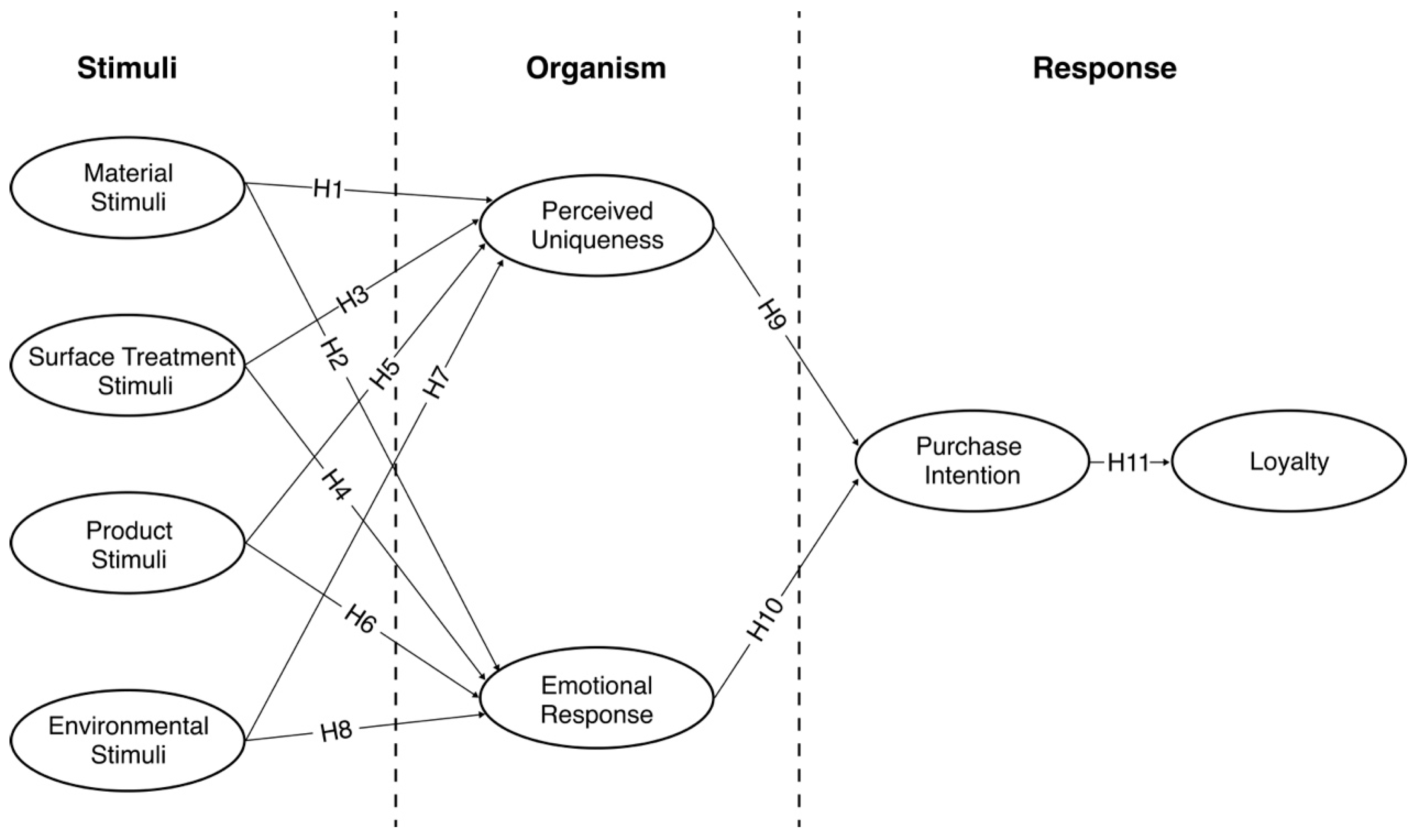
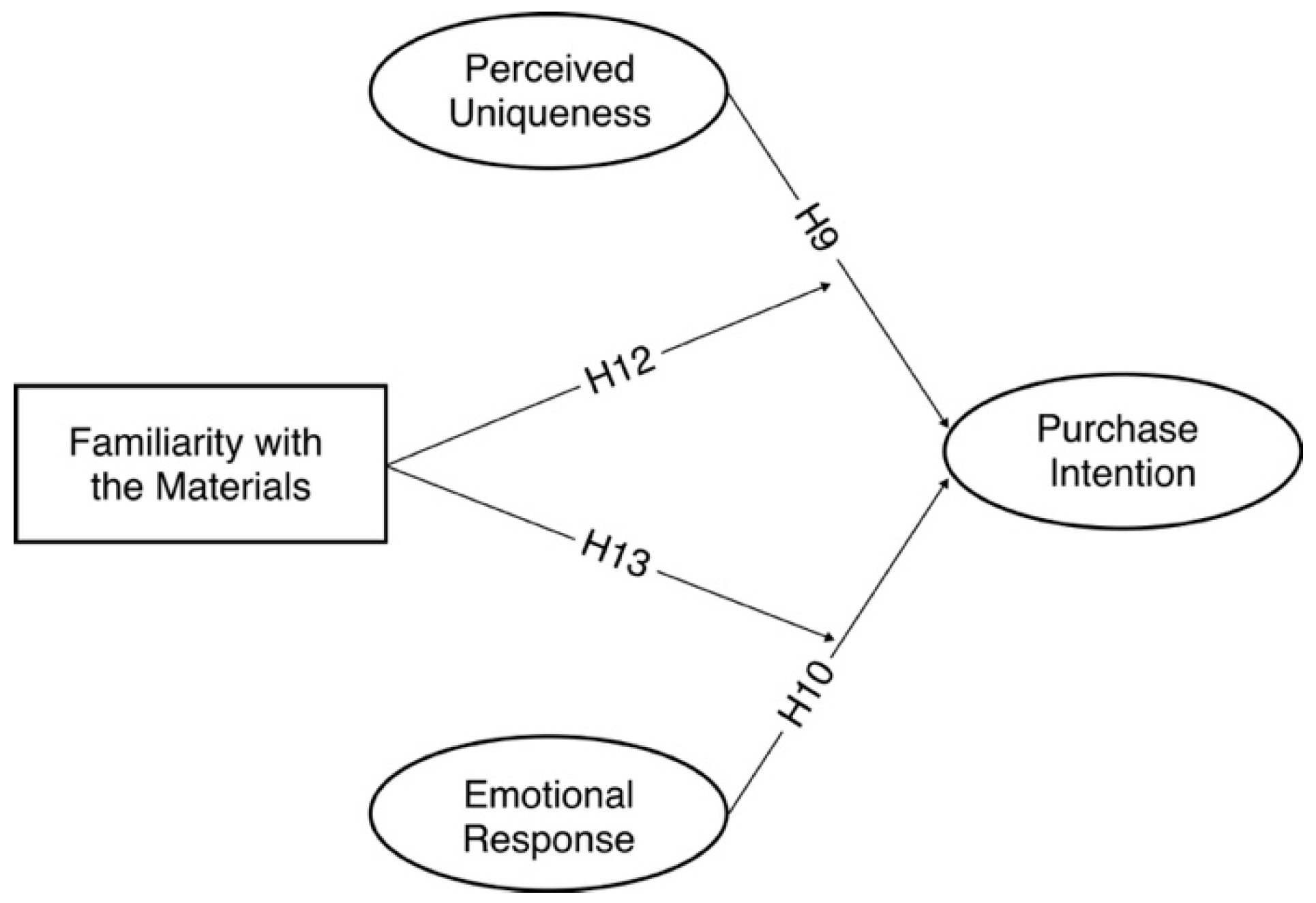
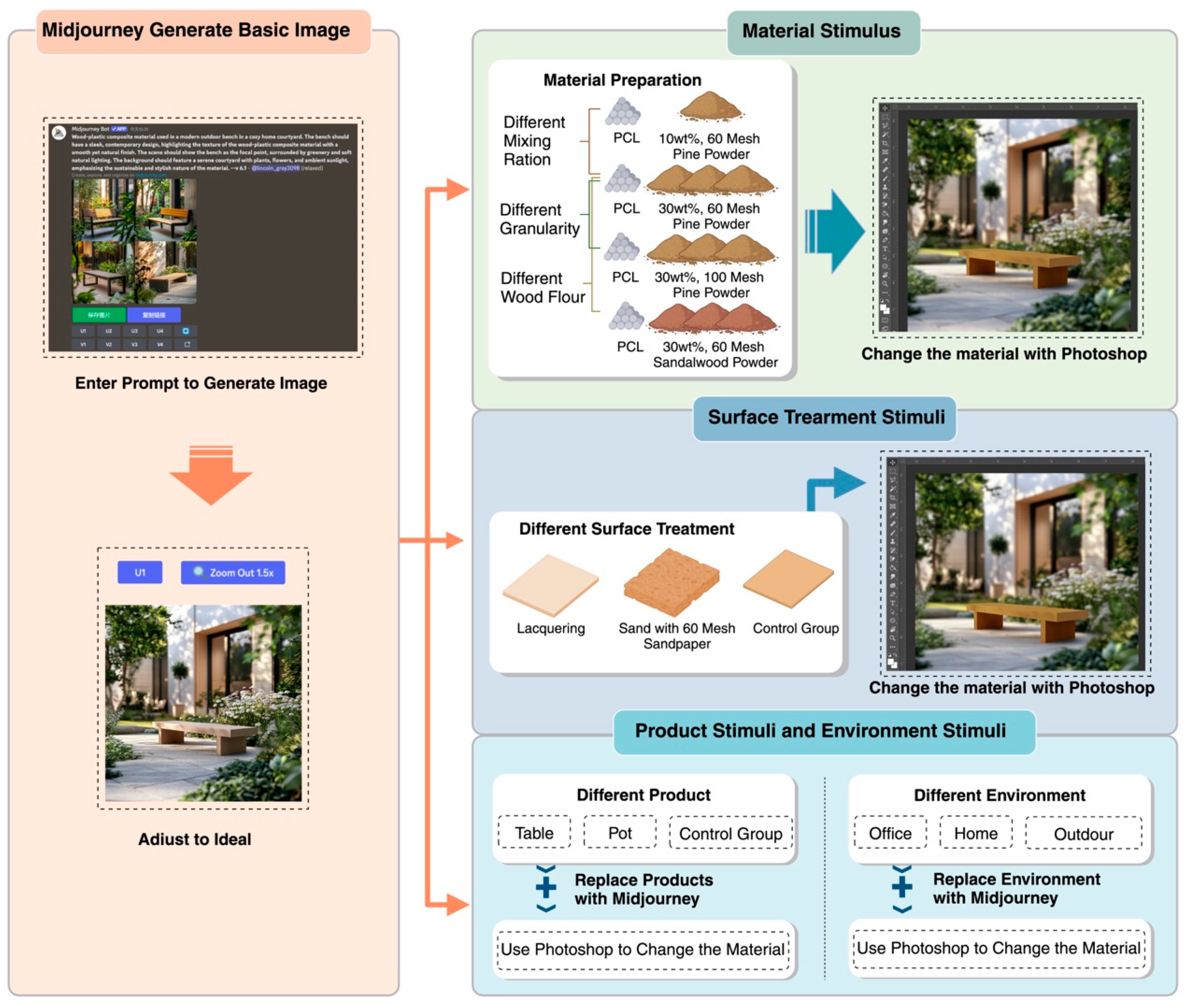
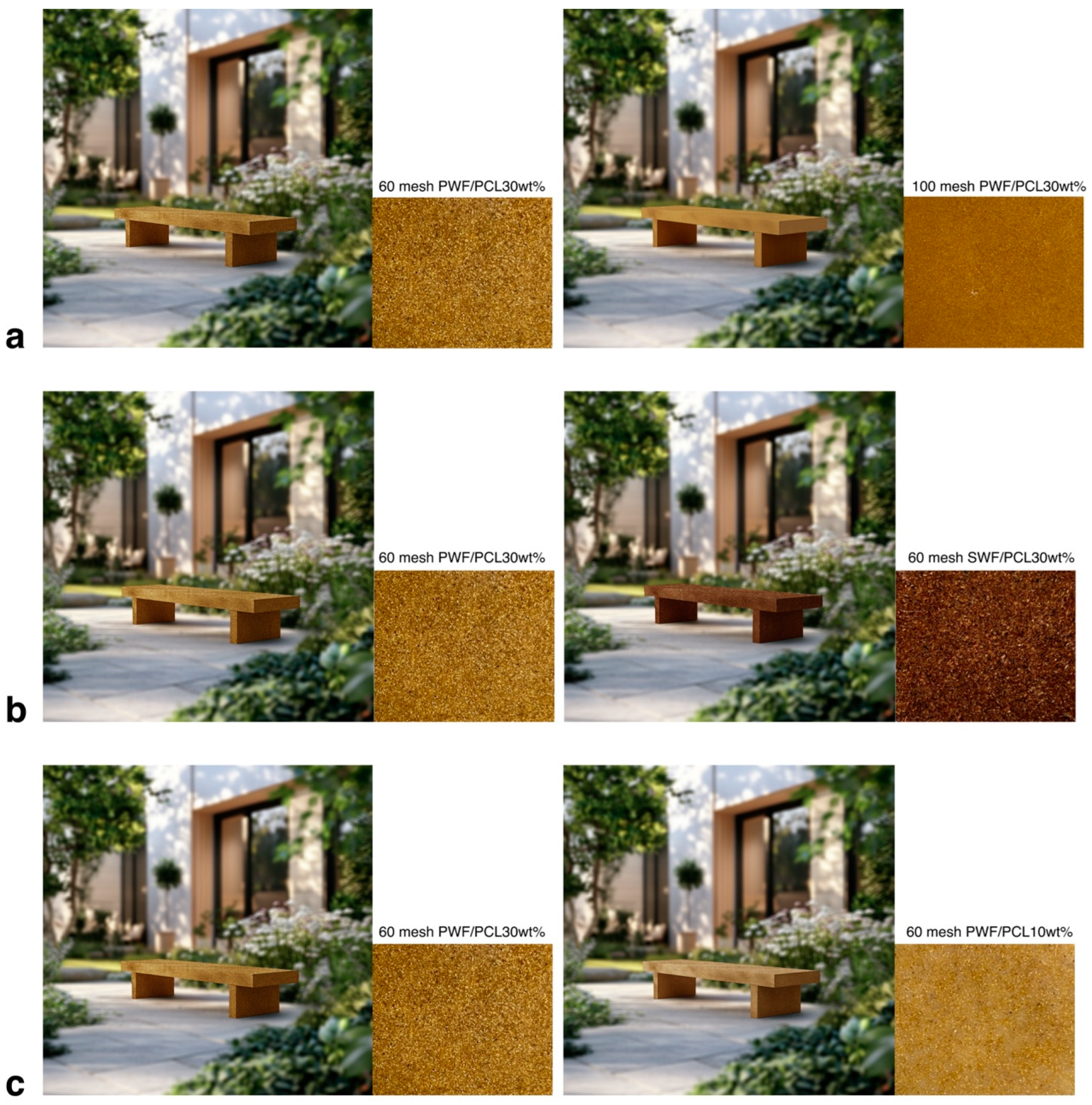

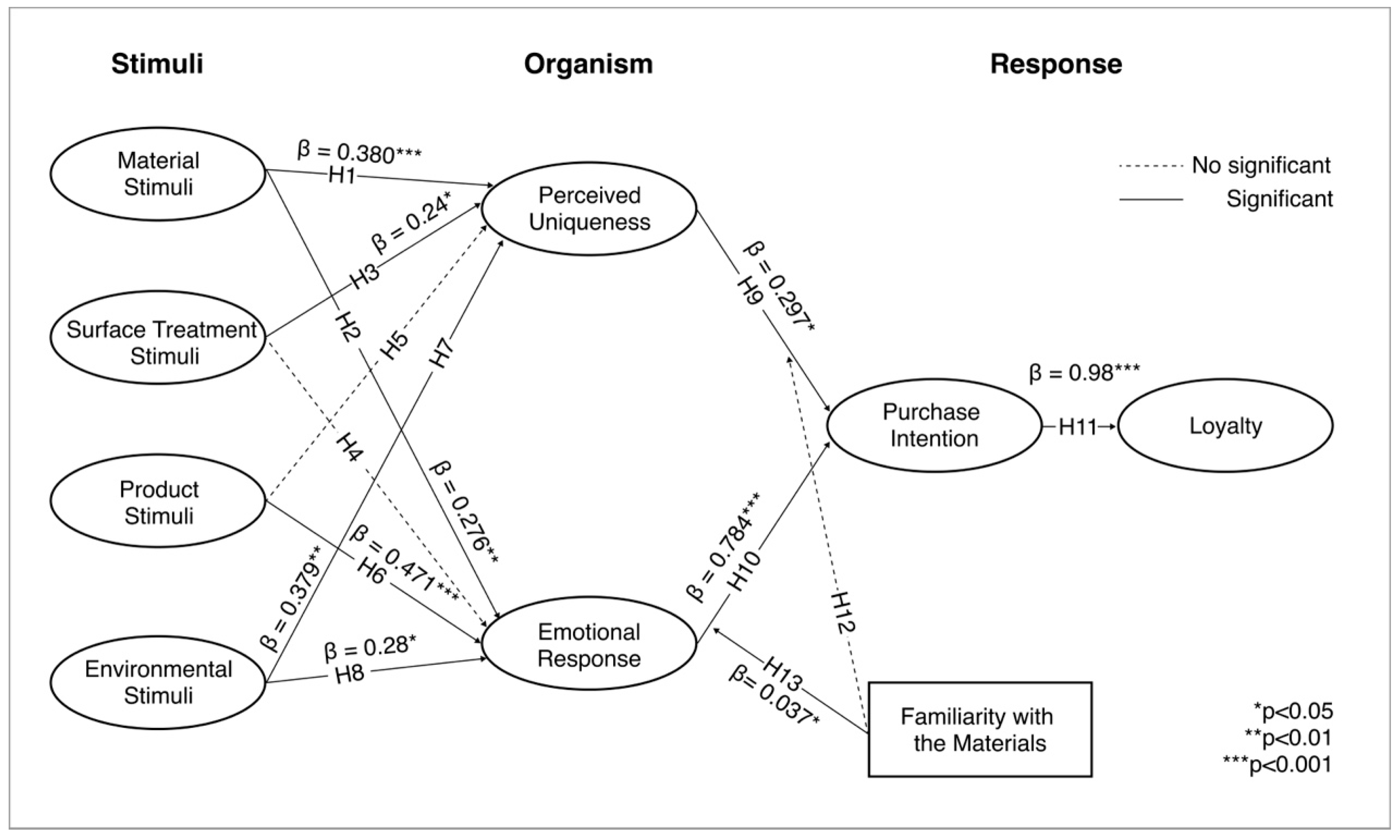
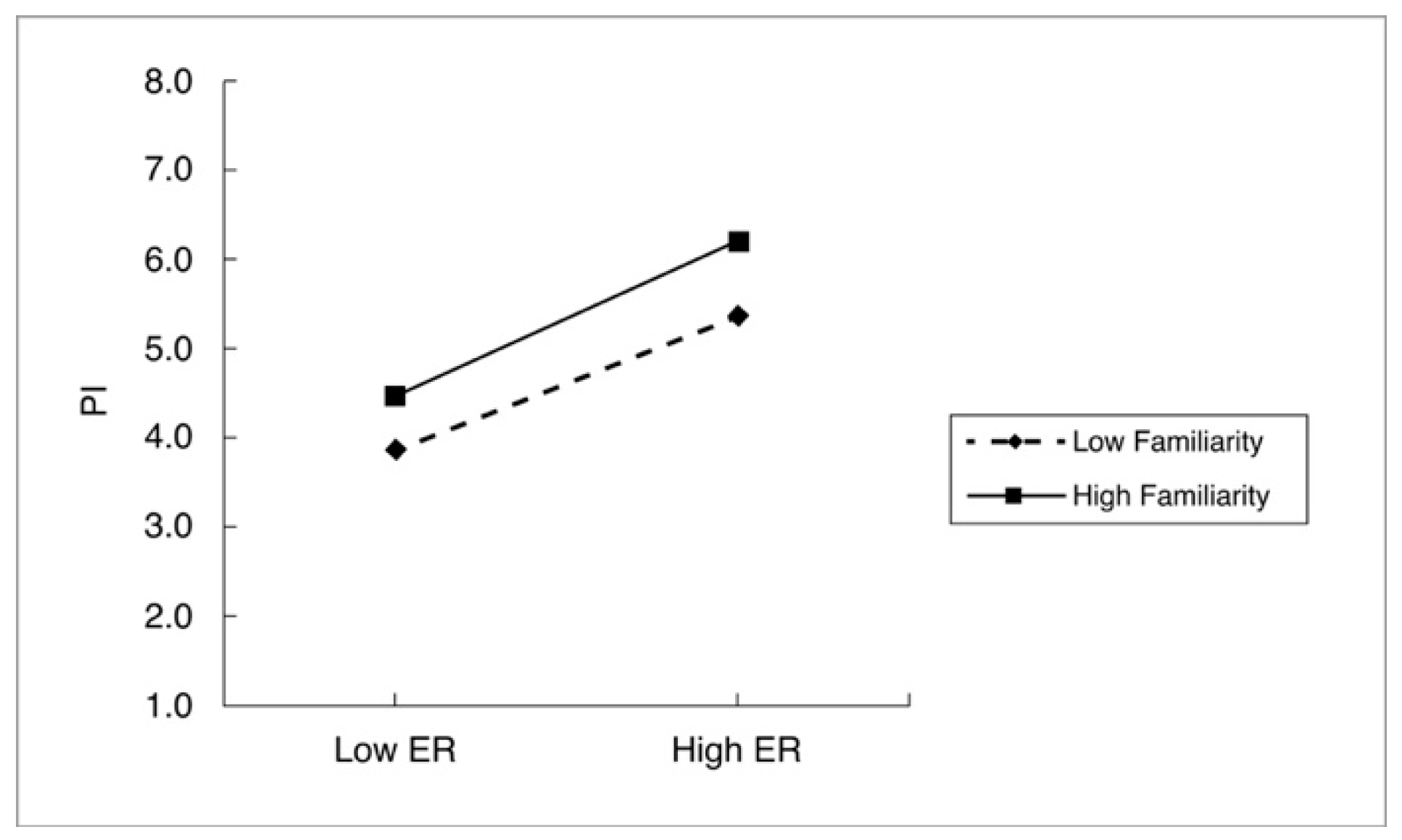
| Construct | Items | Mean (SD) | Loadings | AVE | Composite Reliability |
|---|---|---|---|---|---|
| Material Stimuli (MS) | MS1 | 4.98 (1.59) | 0.852 *** | 0.685 | 0.866 |
| MS2 | 5.18 (1.44) | 0.815 *** | |||
| MS3 | 5.05 (1.52) | 0.815 *** | |||
| Surface Treatment Stimuli (ST) | ST1 | 5.3 (1.39) | 0.820 *** | 0.644 | 0.844 |
| ST2 | 5.35 (1.37) | 0.797 *** | |||
| ST3 | 5.2 (1.4) | 0.791 *** | |||
| Product Stimuli (PS) | PS1 | 5.59 (1.24) | 0.792 *** | 0.601 | 0.82 |
| PS2 | 5.43 (1.32) | 0.745 *** | |||
| PS3 | 5.28 (1.37) | 0.788 *** | |||
| Environmental Stimuli (ES) | ES1 | 5.36 (1.36) | 0.762 *** | 0.591 | 0.812 |
| ES2 | 5.42 (1.34) | 0.772 *** | |||
| ES3 | 5.33 (1.48) | 0.773 *** | |||
| Perceived Uniqueness (PU) | PU1 | 5.32 (1.28) | 0.738 *** | 0.630 | 0.833 |
| PU2 | 5.12 (1.34) | 0.812 *** | |||
| PU3 | 5.01 (1.46) | 0.828 *** | |||
| Emotional Response (ER) | ER1 | 5.44 (1.47) | 0.787 *** | 0.671 | 0.857 |
| ER2 | 5.12 (1.52) | 0.834 *** | |||
| ER3 | 4.98 (1.54) | 0.836 *** | |||
| Purchase Intention (PI) | PI1 | 5.08 (1.48) | 0.824 *** | 0.641 | 0.834 |
| PI2 | 4.82 (1.59) | 0.872 *** | |||
| PI3 | 5.41 (1.32) | 0.695 *** | |||
| Loyalty (LY) | LY1 | 4.86 (1.6) | 0.891 *** | 0.788 | 0.917 |
| LY2 | 4.9 (1.64) | 0.894 *** | |||
| LY3 | 4.93 (1.7) | 0.878 *** |
| MS | ST | PS | ES | PU | ER | PI | LY | |
|---|---|---|---|---|---|---|---|---|
| MS | 0.828 | |||||||
| ST | 0.703 | 0.803 | ||||||
| PS | 0.711 | 0.694 | 0.775 | |||||
| ES | 0.665 | 0.726 | 0.697 | 0.769 | ||||
| PU | 0.751 | 0.749 | 0.694 | 0.720 | 0.794 | |||
| ER | 0.736 | 0.665 | 0.750 | 0.692 | 0.749 | 0.819 | ||
| PI | 0.693 | 0.677 | 0.693 | 0.694 | 0.754 | 0.800 | 0.801 | |
| LY | 0.628 | 0.602 | 0.627 | 0.622 | 0.673 | 0.752 | 0.800 | 0.888 |
| Effects | Effects of PU on LY Mediated Through PI | Effects of ER on LY Mediated Through PI |
|---|---|---|
| Total effect | 0.319 ns | 0.756 *** |
| (lower bound, upper bound) | (−0.120, 0.749) | (0.491, 1.077) |
| Direct effect | −0.285 ns | 0.117 ns |
| (lower bound, upper bound) | (−1.162, 0.153) | (−0.447, 0.478) |
| Indirect effect | 0.615 ** | 0.639 *** |
| (lower bound, upper bound) | (0.201, 1.471) | (0.298, 1.283) |
Disclaimer/Publisher’s Note: The statements, opinions and data contained in all publications are solely those of the individual author(s) and contributor(s) and not of MDPI and/or the editor(s). MDPI and/or the editor(s) disclaim responsibility for any injury to people or property resulting from any ideas, methods, instructions or products referred to in the content. |
© 2025 by the authors. Licensee MDPI, Basel, Switzerland. This article is an open access article distributed under the terms and conditions of the Creative Commons Attribution (CC BY) license (https://creativecommons.org/licenses/by/4.0/).
Share and Cite
Wang, B.; An, S.; Li, K. Shaping Green Choices: How Sensory Cues Drive Behavior of Wood-Plastic Composites. Behav. Sci. 2025, 15, 383. https://doi.org/10.3390/bs15030383
Wang B, An S, Li K. Shaping Green Choices: How Sensory Cues Drive Behavior of Wood-Plastic Composites. Behavioral Sciences. 2025; 15(3):383. https://doi.org/10.3390/bs15030383
Chicago/Turabian StyleWang, Bicheng, Shun An, and Kerun Li. 2025. "Shaping Green Choices: How Sensory Cues Drive Behavior of Wood-Plastic Composites" Behavioral Sciences 15, no. 3: 383. https://doi.org/10.3390/bs15030383
APA StyleWang, B., An, S., & Li, K. (2025). Shaping Green Choices: How Sensory Cues Drive Behavior of Wood-Plastic Composites. Behavioral Sciences, 15(3), 383. https://doi.org/10.3390/bs15030383






